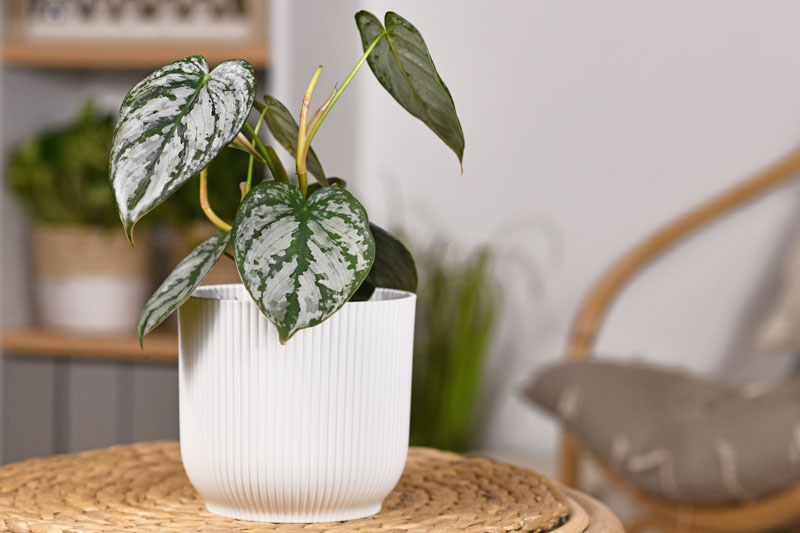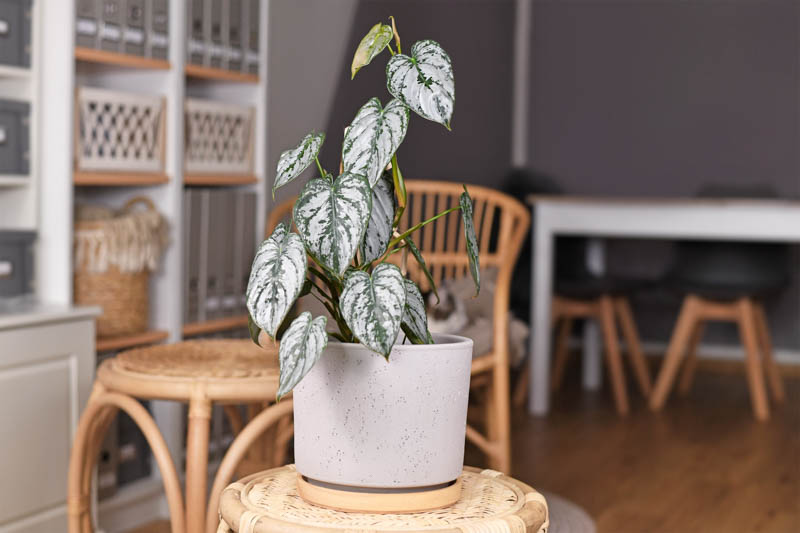Philodendron brandtianum, with its striking olive-green leaves speckled with silver markings, is a captivating species within the diverse Philodendron family. This plant combines the robust, easy-care nature of philodendrons with an aesthetic appeal that makes it a popular choice for both seasoned gardeners and newcomers to plant care.
Philodendron brandtianum is celebrated for its beautiful, heart-shaped leaves that exhibit a unique coloration of olive green with silver or white variegation. The leaves are glossy and have a leathery texture, adding to the plant’s visual appeal. Its trailing or climbing habit makes it a versatile addition to any indoor garden.
Native: Native to the tropical forests of Peru, Bolivia, Brazil, Ecuador, and Colombia, Philodendron brandtianum thrives in warm, humid conditions. In its natural environment, it often grows as an epiphyte, climbing trees with its aerial roots in search of light. Philodendrons belong to the arum family (Araceae), along with Zantedeschia (Calla Lily), Caladium (Angel Wing), Monstera (Swiss Cheese Plant), or Colocasia (Elephant Ear).
Plant Type and Habit: Philodendron brandtianum is a vining philodendron, capable of trailing or climbing depending on the support provided. Its flexibility in growth habit allows for various display options, from hanging baskets to moss poles, making it adaptable to different interior designs and preferences.
Size: When grown indoors, Philodendron brandtianum can reach lengths of 4-5 feet (120-150 cm), both as a climber and a trailer. When grown outdoors, it can grow 15 feet tall (450 cm). Its growth rate is moderate, allowing for manageable care and maintenance. Regular pruning can help control its size and encourage a fuller, bushier plant.
Flowers: While Philodendron brandtianum can produce flowers, it is primarily grown for its attractive foliage. The flowers, typical of the genus, feature a spadix surrounded by a spathe, but are infrequent in household environments and not the plant’s main attraction.
Foliage: The foliage of Philodendron brandtianum is its most notable feature. The striking contrast between the olive-green background and the silver variegation catches the eye, making each leaf a small masterpiece. The variegation patterns can vary, adding to the uniqueness of each plant.
Hardiness: It is hardy in USDA zones 10 to 11 and prefers temperatures between 65°F (18°C) and 85°F (29°C). It requires protection from cold drafts and temperatures below 60°F (15°C).
Uses: Its trailing or climbing nature makes it a flexible choice for adding greenery to living spaces, offices, or anywhere a touch of the tropics is desired.
Toxicity: Philodendrons are toxic to humans, cats, and dogs if ingested. They contain calcium oxalate crystals that can cause mouth and stomach irritation. Contact with the sap may cause skin irritation.
Benefits: Beyond its decorative value, it also serves as an air purifier, improving indoor air quality by filtering out certain toxins.

Light: Prefers bright, indirect light to enhance its variegation. Too much direct sunlight can scorch the leaves, while too little light may reduce the contrast of the variegation. An east or west-facing window with filtered light is ideal.
Soil: Thrives in well-draining, rich, organic soil. A mix containing peat moss, perlite, and orchid bark or vermiculite provides the perfect balance for moisture retention and drainage.
Water: Water when the top inch of soil feels dry. Philodendron brandtianum likes consistent moisture but is susceptible to root rot in overly wet conditions. Ensure the pot has good drainage and reduce watering slightly in winter.
Temperature and Humidity: Prefers warm temperatures between 65°F (18°C) and 85°F (29°C). Protect it from cold drafts and sudden temperature drops to avoid stress. Prefers higher humidity levels, around 60-80%. Use a humidifier, mist the plant regularly, or place it on a pebble tray with water to increase ambient humidity, mimicking its tropical habitat.
Fertilization: Fertilize monthly during the growing season (spring to summer) with a balanced, water-soluble fertilizer diluted to half the recommended strength. Reduce fertilization in fall and winter when growth slows.
Support: BAs a vining plant, Philodendron brandtianum may benefit from a moss pole or trellis to climb, which can encourage larger leaf growth and more pronounced variegation.
Pruning: Prune as needed to control size and shape or to remove any yellow or damaged leaves. Pruning encourages bushier growth and can rejuvenate an overgrown plant.
Repotting: Repot every 2-3 years or when the plant becomes root-bound. Choose a pot only slightly larger than the current one to prevent excess soil moisture.
Propagating Philodendron plants is a straightforward and rewarding process, allowing you to expand your collection or share with friends and family. The most common method is stem cuttings, which can be rooted in water or soil. Here’s how to do it:

Philodendrons can encounter pests, diseases, and other common problems, especially when grown indoors.
Spider Mites: These tiny pests can be identified by the fine webs they weave on the plant. They cause yellowing or speckled leaves. Increase humidity around the plant and wash it with a strong stream of water. For severe infestations, use insecticidal soap or neem oil.
Mealybugs: These white, cottony pests tend to cluster in leaf axils and under leaves, sucking sap and weakening the plant. Remove with alcohol-dipped cotton swabs or apply neem oil.
Aphids: Small, soft-bodied insects that can be green, black, brown, or pink, aphids typically feed in groups on the undersides of leaves. Combat them with a gentle spray of water, neem oil, or insecticidal soap to protect the plant’s health and appearance.
Scale insects: Hard or soft-bodied insects that attach themselves to the stems or leaves, causing yellowing and growth stunting. Scrape off with a fingernail or use a cotton swab dipped in rubbing alcohol. Insecticidal soap or neem oil may also be used.
Root rot: Overwatering is the primary cause, leading to brown, mushy roots and yellowing leaves. Reduce watering, improve drainage, and repot the plant into fresh, well-draining soil. Severely affected roots should be trimmed before repotting.
Leaf spot: Fungal or bacterial infections can cause dark or black spots on leaves, often with a yellow halo. Increase air circulation, avoid wetting leaves when watering, and remove affected leaves. Fungicides or bactericides may be necessary in severe cases.
Yellowing Leaves: Often a sign of overwatering or poor drainage. Ensure the plant is in well-draining soil and adjust your watering schedule to allow the soil to dry slightly between waterings.
Brown Leaf Tips: Can indicate low humidity, especially in dry indoor environments. Increase humidity around the plant with a humidifier, pebble tray, or by misting the leaves regularly.
Leaf Scorch: Direct sunlight can cause the leaves to scorch, leading to brown patches or fading of the vibrant leaf colors. Position the plant in a location where it receives bright, indirect light.
Drooping Leaves: This can be a sign of both underwatering and overwatering. Check the soil moisture to determine the cause and adjust your watering accordingly.
Slow Growth or Lack of Color: Insufficient light can lead to less vibrant leaf coloration and slow growth. Ensure your philodendron is receiving enough indirect light to maintain its rich hues and promote healthy growth.
| Hardiness |
10 - 11 |
|---|---|
| Plant Type | Houseplants, Climbers |
| Plant Family | Araceae |
| Genus | Philodendron |
| Exposure | Partial Sun |
| Season of Interest |
Spring (Early, Mid, Late) Summer (Early, Mid, Late) Fall Winter |
| Height |
4' - 15' (120cm - 4.6m) |
| Spread | 1' (30cm) |
| Maintenance | Low |
| Water Needs | Average |
| Soil Type | Loam |
| Soil pH | Acid, Neutral, Alkaline |
| Soil Drainage | Moist but Well-Drained |
| Characteristics | Showy, Evergreen |
| Tolerance | Deer, Rabbit |
| Garden Uses | Hanging Baskets, Patio And Containers |
| Hardiness |
10 - 11 |
|---|---|
| Plant Type | Houseplants, Climbers |
| Plant Family | Araceae |
| Genus | Philodendron |
| Exposure | Partial Sun |
| Season of Interest |
Spring (Early, Mid, Late) Summer (Early, Mid, Late) Fall Winter |
| Height |
4' - 15' (120cm - 4.6m) |
| Spread | 1' (30cm) |
| Maintenance | Low |
| Water Needs | Average |
| Soil Type | Loam |
| Soil pH | Acid, Neutral, Alkaline |
| Soil Drainage | Moist but Well-Drained |
| Characteristics | Showy, Evergreen |
| Tolerance | Deer, Rabbit |
| Garden Uses | Hanging Baskets, Patio And Containers |
How many Philodendron brandtianum do I need for my garden?
| Plant | Quantity | |
|---|---|---|
| Philodendron brandtianum | N/A | Buy Plants |
Create a membership account to save your garden designs and to view them on any device.
Becoming a contributing member of Gardenia is easy and can be done in just a few minutes. If you provide us with your name, email address and the payment of a modest $25 annual membership fee, you will become a full member, enabling you to design and save up to 25 of your garden design ideas.
Join now and start creating your dream garden!
Create a membership account to save your garden designs and to view them on any device.
Becoming a contributing member of Gardenia is easy and can be done in just a few minutes. If you provide us with your name, email address and the payment of a modest $25 annual membership fee, you will become a full member, enabling you to design and save up to 25 of your garden design ideas.
Join now and start creating your dream garden!